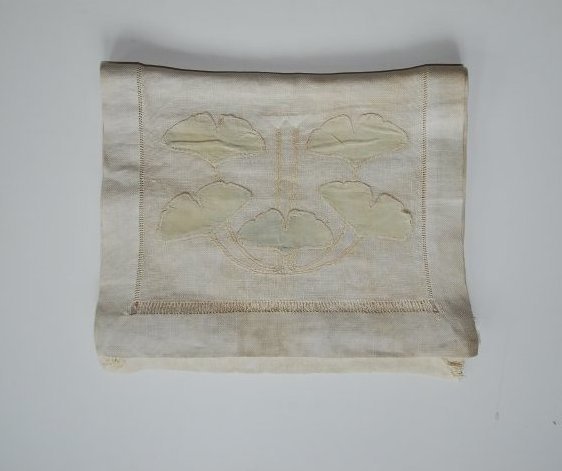Table Scarf (no. 915)
Item
Title
Table Scarf (no. 915)
Creator
Craftsman Workshops
Date
1911 (ca.)
Dimensions
90 x 20 inches
Medium
Linen
Object No.
2000.28
Credit line
Gift of David and Susan Cathers
Description
Stickley’s needlework department demonstrated interest in the gingko as a motif as early as July 1904, but the questions of who designed the work and whether these pieces were in production at that time are more complicated than previously realized. The attribution of the design to Shrimpton is based exclusively on the lettering in the article’s sole illustration, not documentation regarding her role in the design. While it is entirely possible that she designed the motif, she may have also been illustrating designs worked out by others in the department, like Blanche Baxter who ran the department and is documented as receiving payments for designs.
Significantly, the illustrations in the article differ from the execution of the designs illustrated in the following year’s catalog and in later illustrations in The Craftsman. In the gingko portiere—the closest to the design for the curtain illustrated in July 1904—the stalks are markedly more vertical and the leaves lack the tilting rhythm of the earlier work. In the table cover, the curving lines of the design are more muted in the photographed example, and the leaves are somewhat smaller. Most noticeable is the manner in which the design for the pillow is ignored altogether: the design is essentially the same as the table square, though the profile of the leaves has been simplified.
Oddly, and despite the fact that no finished work is illustrated in the article, the author wrote as though the designs were in production, noting that “The materials used here are Craftsman canvas for the body of the articles, linen for the appliqué, and linen for the couching.” Equally curious is that the color scheme mentioned in the article—greens, ranging from dark and brownish to light and yellowish, and a deep red band forming the base of the curtain design—differs significantly from the description and photograph that appeared in the catalog just six months later. By October 1904, however, the gingko motif table scarf appeared in an illustration for the Living Room of Craftsman House no. X, in colors that match the catalog description: “This design is frequently done in deep leaf green appliqué, outlined and couched in a rich cream color, with the buds on the stalks done in brilliant orange.”
Regardless of whether these designs were in production by July 1904 or intended simply to whet the appetite of readers as Stickley finished work on his catalog of needlework, the blend of Asian motifs and continental design strategies were designed to appeal to consumers. As The Craftsman informed its readers: “The capabilities of the gingko for entrance into decoration can scarcely be overestimated. They are apparent at a glance, and have been widely recognized by designers, as well Western as Oriental.”
Significantly, the illustrations in the article differ from the execution of the designs illustrated in the following year’s catalog and in later illustrations in The Craftsman. In the gingko portiere—the closest to the design for the curtain illustrated in July 1904—the stalks are markedly more vertical and the leaves lack the tilting rhythm of the earlier work. In the table cover, the curving lines of the design are more muted in the photographed example, and the leaves are somewhat smaller. Most noticeable is the manner in which the design for the pillow is ignored altogether: the design is essentially the same as the table square, though the profile of the leaves has been simplified.
Oddly, and despite the fact that no finished work is illustrated in the article, the author wrote as though the designs were in production, noting that “The materials used here are Craftsman canvas for the body of the articles, linen for the appliqué, and linen for the couching.” Equally curious is that the color scheme mentioned in the article—greens, ranging from dark and brownish to light and yellowish, and a deep red band forming the base of the curtain design—differs significantly from the description and photograph that appeared in the catalog just six months later. By October 1904, however, the gingko motif table scarf appeared in an illustration for the Living Room of Craftsman House no. X, in colors that match the catalog description: “This design is frequently done in deep leaf green appliqué, outlined and couched in a rich cream color, with the buds on the stalks done in brilliant orange.”
Regardless of whether these designs were in production by July 1904 or intended simply to whet the appetite of readers as Stickley finished work on his catalog of needlework, the blend of Asian motifs and continental design strategies were designed to appeal to consumers. As The Craftsman informed its readers: “The capabilities of the gingko for entrance into decoration can scarcely be overestimated. They are apparent at a glance, and have been widely recognized by designers, as well Western as Oriental.”
Associated names
Louise A. Shrimpton (designer)
Provenance
I think you know that it is a Stickley family textile original to the Farms. Though I'm not certain, it might be the table scarf visible on the sideboard in the photo on page 19 of the Pictorial History. Possibly it was used on the long chestnut (or elm?) directors' table that is now in the Cottage at Crab Tree Farm. Cyril Farny either gave it or sold it for a nominal price to Robert Clark in the early 1970s. I bought it from Robert in the early 1990s and Susan and I gave it to the Farms sometime later in that decade.

